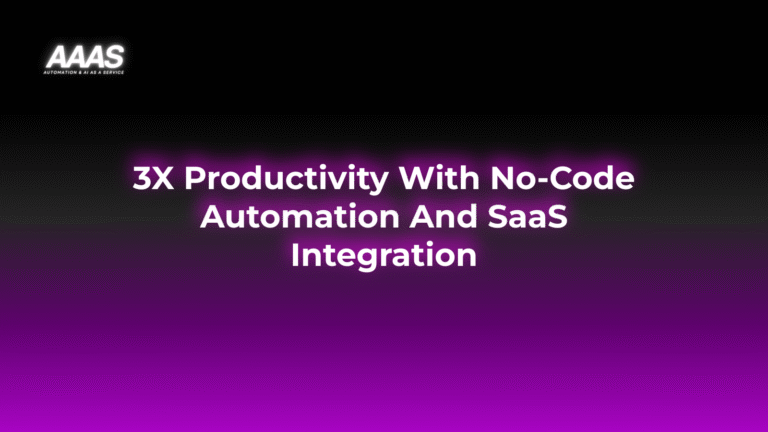Leveraging AI and No-Code Platforms for Workflow Automation in SaaS Businesses

Market Problem
SaaS businesses often struggle with manual, repetitive tasks that drain productivity, create bottlenecks, and inhibit scalability. Common issues include:
- High operational costs due to manual labor
- Error-prone workflows impacting customer experience
- Lack of integration between disparate systems
- Difficulty scaling processes across teams and geographies
Solution & Benefits
AI-powered and no-code workflow automation platforms empower SaaS companies to:
- Automate repetitive tasks with minimal coding
- Integrate SaaS tools quickly using visual workflows
- Reduce errors and improve process consistency
- Boost productivity by freeing teams for higher-value work
- Accelerate scalability while maintaining lean operations
- Deliver measurable ROI via time and cost savings
Real Use Cases
- Lead Qualification: Automate scoring and routing of inbound leads using AI and connect to CRM instantly.
- Customer Support Automation: Deploy chatbots and automated ticket triage for 24/7 assistance.
- Billing and Subscription Management: Sync payment platforms and automate invoicing workflows.
- Onboarding Sequences: Automatically guide new users through tailored onboarding paths via email, in-app notifications, and tutorials.
- Contract Approvals: Route documents for e-signature and compliance checks without manual intervention.
Technical Details
Key Platforms
- Zapier – Automate SaaS integrations, offers AI-powered steps, thousands of connectors
- Make (formerly Integromat) – Advanced no-code scenario creation for multi-step logic
- Microsoft Power Automate – Enterprise-grade, deep integration with Microsoft ecosystem
- UiPath – Robust AI automations, RPA for complex backend processes
- Parabola – Data transformation and process automation for SaaS
Core Features
- Drag-and-drop workflow builder
- Pre-built automation templates
- AI-powered decision steps (e.g., intent recognition, summarization)
- Conditional logic, error handling, scheduling
- API integrations and webhooks for custom connections
- Real-time analytics and monitoring dashboards
Security & Compliance
- Role-based access controls
- Audit logs for workflow runs
- SOC 2, GDPR, and HIPAA compliance features (platform-dependent)
Comparison with Alternatives
| Criteria | AI/No-Code Automation | Traditional Coding | Manual Processes |
|---|---|---|---|
| Setup Speed | Instant – days | Weeks – months | N/A |
| Cost | Subscription-based, predictable | High upfront development | Ongoing labor cost |
| Scalability | High | Medium | Low |
| Adaptability | Point-and-click updates | Code changes required | Manual re-training |
| Automation Depth | High (with AI logic) | Custom, but resource intensive | Low |
Pricing Table
| Platform | Monthly Cost (Entry) | Monthly Cost (Business/Pro) | Notable Inclusions |
|---|---|---|---|
| Zapier | $19.99 | $49–$69 | Thousands of integrations, AI actions, multi-step Zaps |
| Make | $9 | $29–$82 | Unlimited scenarios, advanced scheduling, 1M+ operations |
| Power Automate | $15 | $40 | Microsoft 365, AI Builder add-on, 5000+ connectors |
| Parabola | $80 | $400 | Advanced data-flow, email integrations, premium connectors |
Prices as of . Please check vendor sites for latest pricing.
ROI-Focused Practical Examples
- Example 1: Automating lead capture to CRM saves a sales team 90+ hours/month. At $30/hour, annual savings reach $32,400.
- Example 2: Automating invoice reconciliation reduces finance workload by 70%, decreases errors, and accelerates cash flow by 18%.
- Example 3: AI-enhanced onboarding increases user activation rates by 22%, boosting customer lifetime value.
According to McKinsey, intelligent automation offers up to 30% cost savings and significant reductions in turnaround time for SaaS operations.
Setup Steps
- Define automation goals and KPIs (e.g., process time, error reduction).
- Map current workflows and identify bottlenecks.
- Select the right no-code/AI platform for your SaaS stack.
- Design and build visual workflows using in-platform templates.
- Test automations with sample data and edge cases.
- Set permissions, alerts, and monitoring rules.
- Deploy to production and monitor ongoing performance.
- Iterate based on analytics and stakeholder feedback.
Pros and Cons
| Pros | Cons |
|---|---|
|
|
Expert Tips
- Start with high-impact, low-complexity automations to drive early wins.
- Regularly audit automations for errors and optimization opportunities.
- Involve business and technical stakeholders in workflow mapping to maximize adoption.
- Leverage AI features for intelligent routing and predictive workflows.
- Check platform compliance features for your region and data requirements.
- Maintain clear documentation for all automations to facilitate updates and onboarding.
- Integrate monitoring and alerts to proactively address failures.
FAQ
Is coding experience required to deploy AI or no-code automations?
Most modern no-code platforms are designed for non-developers. However, some advanced features or custom connectors may need light scripting or API knowledge.
How secure are AI and no-code workflow automation platforms?
Leading platforms implement robust security features—access controls, regular audits, encryption, and compliance certifications. Always review each platform’s security documentation.
Can AI-powered automations replace all manual workflow tasks?
While AI and automation can eliminate a large percentage of repetitive tasks, processes with highly subjective judgment or exceptions may still require human oversight.
Which SaaS apps can be integrated?
Most popular SaaS apps (CRMs, ERPs, support desks, billing) are supported with thousands of pre-built connectors. Custom apps can often be integrated via API/webhooks.
What internal adoption challenges should be expected?
Ensure strong change management. Involve end users in workflow design and provide training for higher adoption rates.
References
- McKinsey – Automation and the future of work
- Zapier Resources – Automation Guides
- Gartner – No-Code Application Platforms
- Forrester – Economic Impact of Microsoft Power Apps
Last updated:







